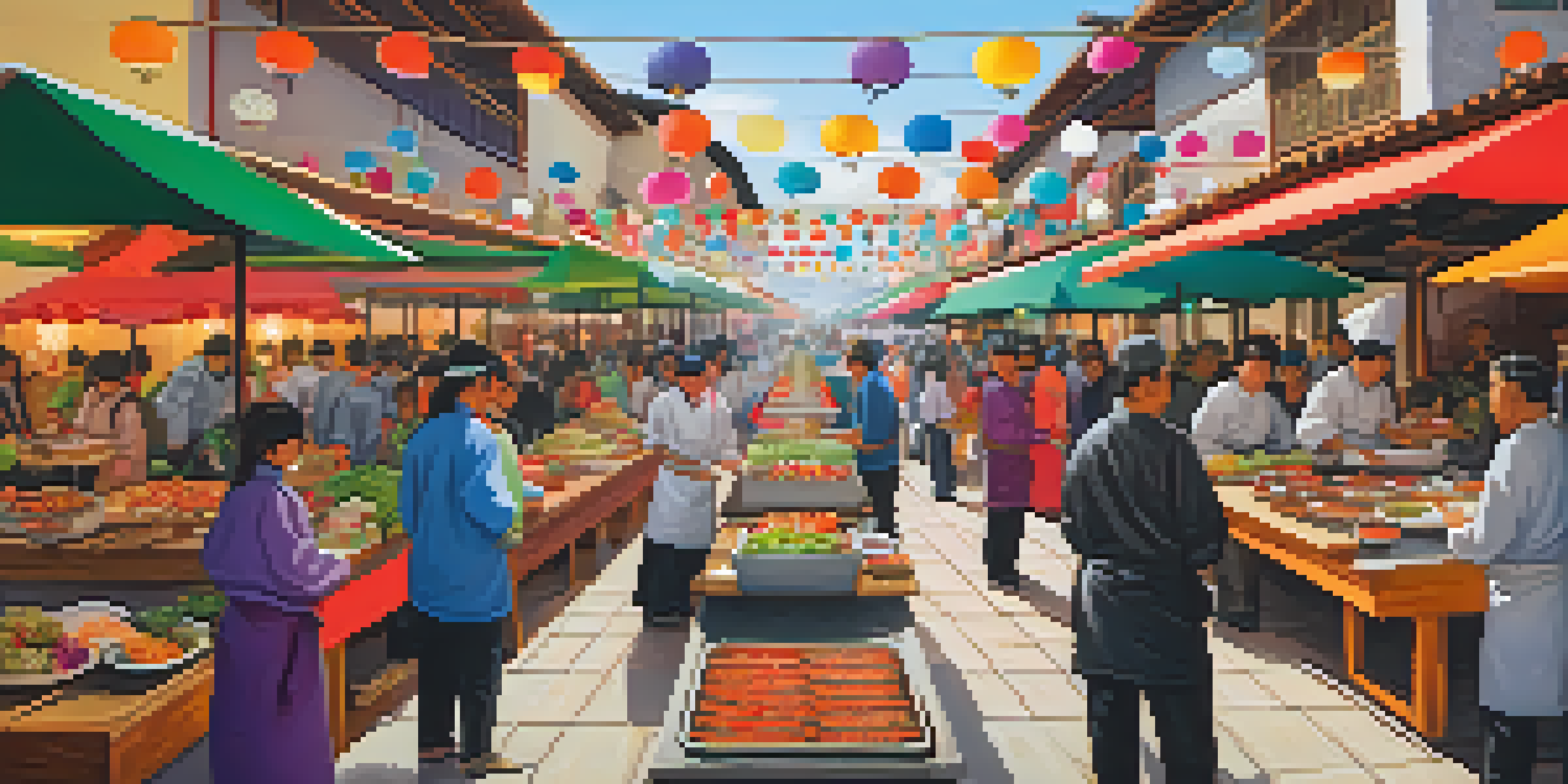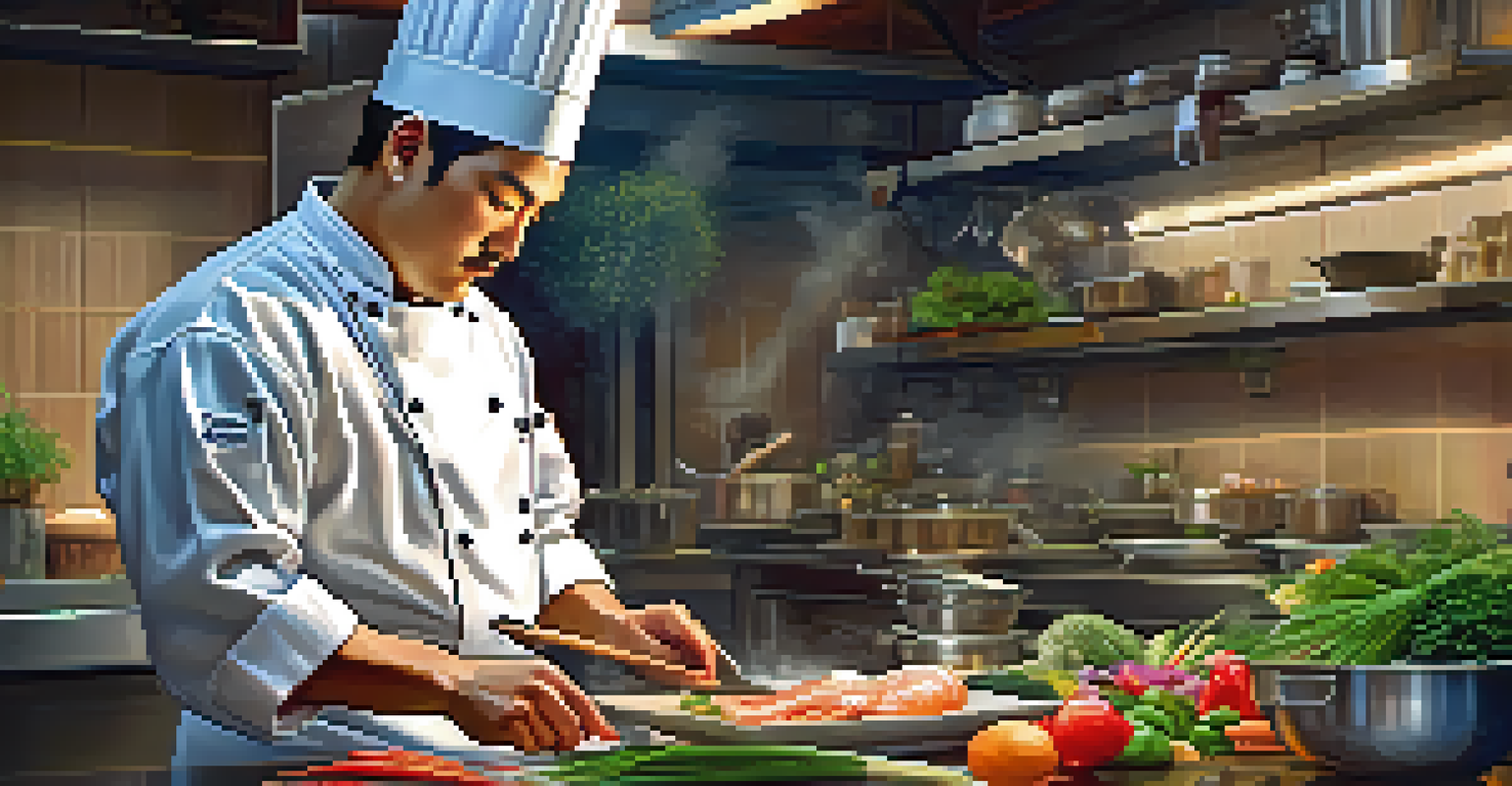The Influence of Japanese Cuisine on Peruvian Gastronomy

The Arrival of Japanese Immigrants in Peru
In the early 20th century, Japan experienced significant social and economic changes, prompting many Japanese to seek new opportunities abroad. Peru became a popular destination due to its vibrant economy and agricultural potential. The arrival of these immigrants not only introduced new agricultural techniques but also laid the foundation for a cultural exchange that would forever change Peruvian gastronomy.
Food is a universal language that speaks to the heart and soul of every culture.
The Japanese community began to establish businesses, particularly in the fishing and agricultural sectors. They brought with them a deep respect for fresh, high-quality ingredients, which resonated with the existing Peruvian culinary traditions. This blending of values fostered an environment ripe for culinary innovation, leading to the emergence of unique dishes that combined elements from both cultures.
As the years passed, the Japanese community became an integral part of Peruvian society, enriching its culinary landscape. Their contributions went beyond just food; they also influenced local cooking techniques and introduced new flavors, setting the stage for an exciting fusion that would captivate the taste buds of many.
Culinary Techniques: A Cross-Cultural Exchange
One of the most significant contributions of Japanese cuisine to Peruvian gastronomy is the introduction of unique cooking techniques. Methods such as sushi rolling and sashimi preparation found their way into the hearts and kitchens of Peruvians, leading to an exciting culinary revolution. These techniques provided a new approach to presenting fresh seafood, which is abundant in Peru.

The use of marinades, such as soy sauce and rice vinegar, became popular in Peruvian kitchens, enhancing the flavors of traditional dishes. For instance, the classic ceviche was elevated with a hint of umami, creating a delightful fusion that many locals and visitors adore. This blending of techniques showcases how culinary traditions can evolve and adapt over time.
Culinary Fusion of Japan and Peru
The arrival of Japanese immigrants in Peru sparked a unique culinary exchange, leading to the creation of innovative dishes that blend traditional flavors from both cultures.
Moreover, the emphasis on aesthetics in Japanese cuisine influenced how dishes were plated in Peru. The visual appeal of food became equally important, inspiring chefs to create beautiful arrangements that highlighted the freshness of ingredients, making dining an artful experience.
The Birth of Nikkei Cuisine
Nikkei cuisine, a term combining 'Nikkei' (Japanese immigrants) and 'Peruvian,' refers to the unique culinary style that emerged from this cross-cultural exchange. This fusion resulted in innovative dishes that celebrate both Japanese and Peruvian flavors. Popular examples include tiradito with a soy sauce twist and sushi rolls featuring local ingredients like mango and aji.
Cooking is like love; it should be entered into with abandon or not at all.
Chefs who identify with Nikkei cuisine often use traditional Peruvian ingredients in their Japanese recipes, showcasing the versatility of both culinary traditions. This creative approach not only highlights the abundance of Peru's natural resources but also honors the rich history of the Japanese community in the country.
As Nikkei cuisine gained popularity, it began to receive international recognition, putting Peru on the culinary map. Food enthusiasts worldwide started to explore this exciting fusion, sparking interest in the stories behind the dishes and the cultures that inspired them.
The Influence of Ingredients: A Flavorful Collaboration
In Peruvian cuisine, the incorporation of Japanese ingredients has added depth and complexity to traditional dishes. Ingredients such as miso, wasabi, and nori have seamlessly blended into local recipes, creating new flavor profiles that excite the palate. For instance, miso has found its way into soups and sauces, enhancing the umami flavors of classic Peruvian fare.
Peru's diverse range of ingredients also complements Japanese cuisine. The use of fresh seafood from the Pacific coast has become a hallmark of both cuisines, allowing for creative reinterpretations of dishes like sushi and ceviche. This collaboration highlights the beauty of utilizing local resources to honor both culinary heritages.
Emergence of Nikkei Cuisine
Nikkei cuisine, a fusion of Japanese and Peruvian culinary traditions, showcases the versatility of local ingredients while gaining international recognition.
As chefs continue to experiment with these ingredients, they create dishes that tell a story of cultural unity and innovation. This flavorful collaboration not only enhances the dining experience but also fosters a deeper appreciation for the culinary traditions of both Japan and Peru.
Cultural Events Celebrating Nikkei Cuisine
Culinary festivals and events celebrating Nikkei cuisine have gained traction in Peru, bringing together chefs, food enthusiasts, and cultural ambassadors. These events showcase the rich tapestry of flavors and techniques that define this unique culinary style. Attendees have the opportunity to taste innovative dishes, attend cooking demonstrations, and learn about the cultural significance behind each creation.
One notable event is the annual Nikkei Festival, where chefs from around the country gather to present their interpretations of Nikkei cuisine. This celebration not only highlights the creativity of the chefs but also serves as a platform for dialogue about the shared history of Japanese and Peruvian cultures. It fosters a sense of community and pride in the culinary achievements of both groups.
Moreover, these events invite international chefs to participate, further promoting the global appreciation of Nikkei cuisine. As people from diverse backgrounds come together to celebrate food, the cultural exchange continues to thrive, enhancing the understanding and enjoyment of this remarkable fusion.
Nikkei Cuisine: A Global Phenomenon
As the world becomes more interconnected, Nikkei cuisine has gained recognition beyond the borders of Peru. Restaurants specializing in this fusion have opened in major cities worldwide, showcasing the delightful blend of Japanese and Peruvian flavors. Food critics and enthusiasts alike have praised this culinary style for its creativity and depth, making it a sought-after experience.
One of the reasons for its global appeal is the emphasis on fresh ingredients and bold flavors. Diners are increasingly drawn to cuisines that prioritize quality and sustainability, values deeply rooted in both Japanese and Peruvian culinary traditions. This alignment has allowed Nikkei cuisine to resonate with a broader audience, making it a culinary trend that shows no signs of slowing down.
Cultural Events Promote Nikkei Food
Culinary festivals celebrating Nikkei cuisine foster community pride and enhance the cultural dialogue between Japan and Peru, highlighting the rich heritage of both.
As chefs continue to innovate and expand the boundaries of Nikkei cuisine, the world eagerly awaits what delicious creations will emerge next. The fusion of these two culinary worlds not only tantalizes the taste buds but also tells a story of cultural exchange that enriches our global food landscape.
The Future of Japanese Influence in Peruvian Gastronomy
The influence of Japanese cuisine on Peruvian gastronomy is an ongoing journey of discovery and innovation. As new generations of chefs emerge, they bring fresh perspectives and creative ideas to the table. This evolution ensures that the culinary dialogue between Japan and Peru continues to thrive, resulting in exciting new dishes and experiences.
Moreover, the growing interest in sustainable and local sourcing of ingredients aligns perfectly with the philosophies of both culinary traditions. Chefs are increasingly focused on creating dishes that not only celebrate cultural heritage but also respect the environment. This commitment to sustainability will likely shape the future of Nikkei cuisine, paving the way for even more innovative creations.

As we look ahead, the possibilities for the fusion of these two rich culinary traditions are limitless. With each new dish, we celebrate the shared history and the vibrant flavors that continue to unite these cultures, ensuring that the influence of Japanese cuisine on Peruvian gastronomy remains a dynamic and delicious journey.